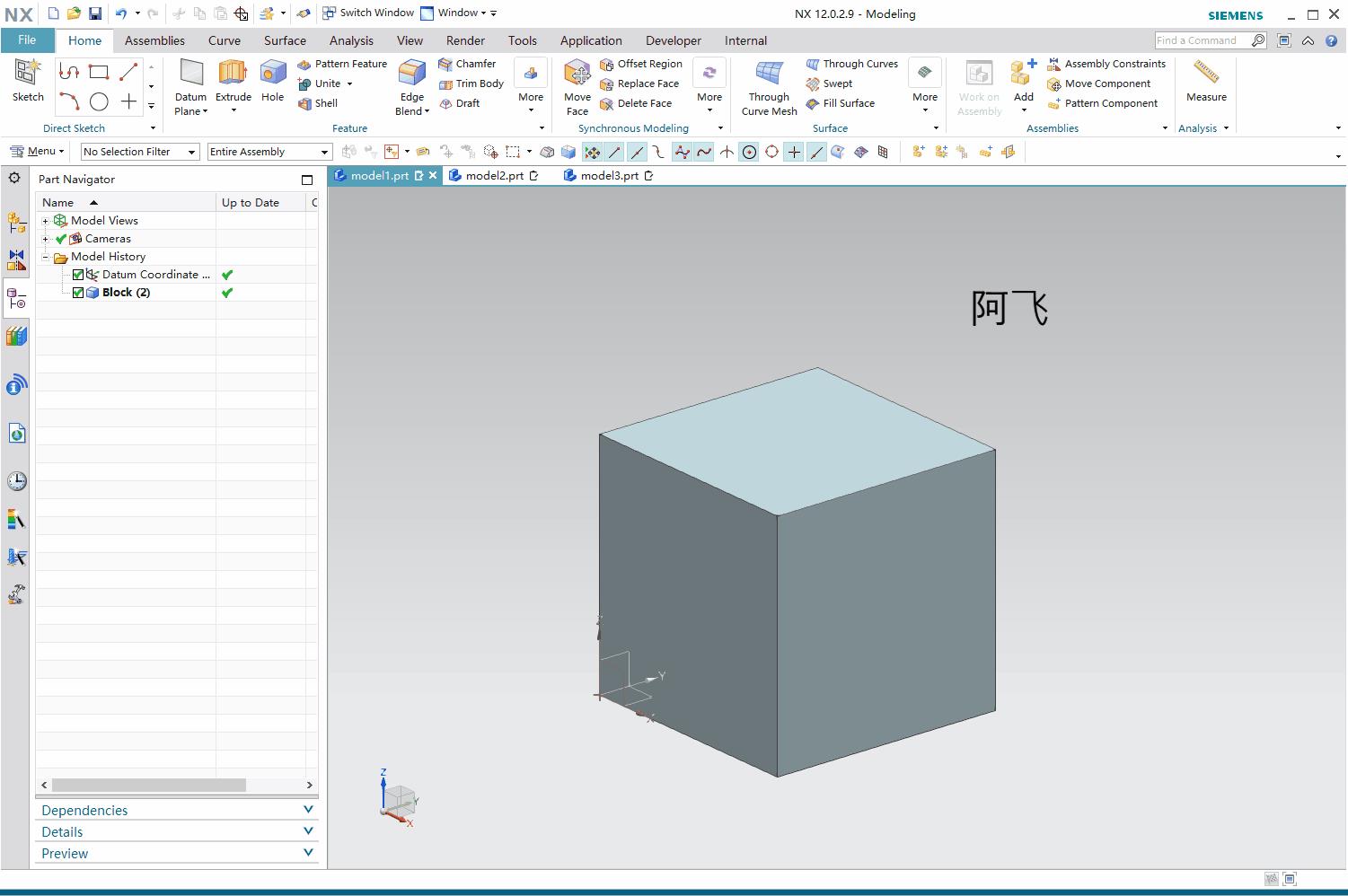NX二次开发-NXOpenC++部件操作
Posted 阿飞的技术博客
tags:
篇首语:本文由小常识网(cha138.com)小编为大家整理,主要介绍了NX二次开发-NXOpenC++部件操作相关的知识,希望对你有一定的参考价值。
版本NX12+VS2015
部件(Part)文件在某种程度上是一个数据库,包含了所有的零件几何信息,同时也包含了大量的非几何信息。
NXOpen API提供了PartCollection集合对象和Part类对象来实现对Session中部件文件的遍历和操作,
这些类对象的属性和成员函数可以实现NX图形界面下的所有对部件文件的访问和操作。
------------------------------------------------------------------------------------------------------
- 部件文件遍历
NX允许用户打开多个部件文件,同时可以通过NX主界面中Windows菜单项下的子菜单选择实现已打开部件文件的切换。
NXOpen API通过PartCollection来实现对所有部件文件的遍历。
PartCollection是Session里面所有Part的集合,通过PartCollection的迭代器(iterator)遍历所有的Part。典型的遍历代码格式如下:
NX12+VS2015
#include <uf_defs.h> #include <NXOpen/Session.hxx> #include <NXOpen/Part.hxx> #include <NXOpen/PartCollection.hxx> #include <NXOpen/ListingWindow.hxx> using namespace NXOpen; extern "C" DllExport int ufusr_ask_unload() { return (int)NXOpen::Session::LibraryUnloadOptionImmediately; } extern "C" DllExport void ufusr(char *param, int *retCode, int paramLen) { //通过Session的静态函数得到NX Session实例对象 Session *theSession = NXOpen::Session::GetSession(); //通过Parts属性得到PartCollection集合对象 PartCollection *partList = theSession->Parts(); //通过iterator迭代器遍历所有Part for (PartCollection::iterator itr = partList->begin(); itr != partList->end(); ++itr) { //转换 BasePart *processPart = *itr; //打印Part的名字 theSession->ListingWindow()->Open(); theSession->ListingWindow()->WriteLine(processPart->Name()); } } 阿飞 2021年6月7日
API说明
1.通过Session的静态函数得到NX Session实例对象

2.通过Parts属性得到PartCollection集合对象

3.通过iterator迭代器遍历所有Part


演示

------------------------------------------------------------------------------------------------------
- 显示部件和工作部件操作
NX部件有两种不同的工作方式,工作部件(Work Part)和显示部件(Display Part)。
NX图形界面上显示的部件定义为显示部件,可以通过PartCollection对象的Display属性
得到当前NX的显示部件。工作部件只有一个,可以通过PartCollection的Work属性得到
当前NX的工作部件。当一个部件被定义为工作部件时,其他部件将被显示为灰色。在NX
交互模式下,只有工作部件才能进行修改编辑操作。
通过PartCollection可以获取当前的工作部件和显示部件
NX12+VS2015 #include <uf_defs.h> #include <NXOpen/Session.hxx> #include <NXOpen/Part.hxx> #include <NXOpen/PartCollection.hxx> #include <NXOpen/ListingWindow.hxx> using namespace NXOpen; extern "C" DllExport int ufusr_ask_unload() { return (int)NXOpen::Session::LibraryUnloadOptionImmediately; } extern "C" DllExport void ufusr(char *param, int *retCode, int paramLen) { //通过Session的静态函数得到NX Session实例对象 Session *theSession = NXOpen::Session::GetSession(); //获得NX显示部件 Part *displayPart(theSession->Parts()->Display()); //获得NX工作部件 Part *workPart(theSession->Parts()->Work()); //打印 char msg[256]; sprintf(msg, "当前显示部件为:%s\\n当前工作部件为:%s", displayPart->Name().GetLocaleText(), workPart->Name().GetLocaleText()); theSession->ListingWindow()->Open(); theSession->ListingWindow()->WriteLine(msg); } 阿飞 2021年6月7日
API说明
1.获得NX显示部件

2.获得NX工作部件

3.NXString转char*

演示

设置新工作部件
设置新显示部件
------------------------------------------------------------------------------------------------------
- 创建新部件
PartCollection集合类对象为开发人员提供了两种创建新Part的方式。最简单的方式
是调用函数NewDisplay直接创建一个".prt"部件,也可以创建一个FileNew类对象,设置创建新Part对象的所有参数,
创建一个新的Part对象。
创建一个新的".prt部件",并设置为显示部件
NX12+VS2015 #include <uf_defs.h> #include <NXOpen/NXException.hxx> #include <NXOpen/Session.hxx> #include <NXOpen/Builder.hxx> #include <NXOpen/FileNew.hxx> #include <NXOpen/NXObject.hxx> #include <NXOpen/Part.hxx> #include <NXOpen/PartCollection.hxx> #include <NXOpen/Session.hxx> #include <NXOpen/ListingWindow.hxx> using namespace NXOpen; extern "C" DllExport int ufusr_ask_unload() { return (int)NXOpen::Session::LibraryUnloadOptionImmediately; } extern "C" DllExport void ufusr(char *param, int *retCode, int paramLen) { //通过Session的静态函数得到NX Session实例对象 Session *theSession = NXOpen::Session::GetSession();
//调用函数NewDisplay直接创建一个".prt"部件,并设置为显示部件 Part *newPart = theSession->Parts()->NewDisplay("D:\\\\1\\\\2\\\\456.prt", Part::UnitsMillimeters); //打印当前prt名字 theSession->ListingWindow()->Open(); theSession->ListingWindow()->WriteLine(newPart->Name()); } 阿飞 2021年6月7日
API说明
1.调用函数NewDisplay直接创建一个".prt"部件,并设置为显示部件

演示

FileNew类继承自Builder类,用于辅助创建Part对象。开发人员可以通过
PartCollection对象的FileNew方法创建一个FileNew对象实例,设置创建新文件的模块、
模板文件名称、新部件文件名称等,最后调用Commit方法生成一个新的Part文件。
NX12+VS2015 #include <uf_defs.h> #include <NXOpen/NXException.hxx> #include <NXOpen/Session.hxx> #include <NXOpen/Builder.hxx> #include <NXOpen/FileNew.hxx> #include <NXOpen/NXObject.hxx> #include <NXOpen/Part.hxx> #include <NXOpen/PartCollection.hxx> #include <NXOpen/Session.hxx> #include <NXOpen/ListingWindow.hxx> using namespace NXOpen; extern "C" DllExport int ufusr_ask_unload() { return (int)NXOpen::Session::LibraryUnloadOptionImmediately; } extern "C" DllExport void ufusr(char *param, int *retCode, int paramLen) { //通过Session的静态函数得到NX Session实例对象 Session *theSession = NXOpen::Session::GetSession(); //通过PartCollection对象创建FileNew实例 FileNew *fileNew1 = theSession->Parts()->FileNew(); //设置模板文件名称 fileNew1->SetTemplateFileName("model-plain-1-mm-template.prt"); //设置创建新Part进入的模块 fileNew1->SetApplication(FileNewApplicationModeling); //设置新Part的单位 fileNew1->SetUnits(Part::UnitsMillimeters); //设置新Part的路径名称 fileNew1->SetNewFileName("D:\\\\1\\\\2\\\\123.prt"); //设置是否使用空模板文件 fileNew1->SetUseBlankTemplate(false); //是否将新创建的Part设置显示部件 fileNew1->SetMakeDisplayedPart(true); //调用Commit方法创建新Part NXObject *nXObject1 = fileNew1->Commit(); //销毁FileNew临时对象 fileNew1->Destroy(); //动态类型转换为Part类对象 Part *newPart(dynamic_cast<Part*>(nXObject1)); //打印当前prt名字 theSession->ListingWindow()->Open(); theSession->ListingWindow()->WriteLine(newPart->Name()); } 阿飞 2021年6月7日
API说明
1.通过PartCollection对象创建FileNew实例


2.公共成员函数继承自NXOpen::Buider


演示

------------------------------------------------------------------------------------------------------
- 部件文件加载
PartCollection集合对象提供了方法从系统中加载一个Part文件得到一个Part类对象
NX12+VS2015
#include <uf_defs.h> #include <NXOpen/NXException.hxx> #include <NXOpen/Session.hxx> #include <NXOpen/Builder.hxx> #include <NXOpen/FileNew.hxx> #include <NXOpen/NXObject.hxx> #include <NXOpen/Part.hxx> #include <NXOpen/PartCollection.hxx> #include <NXOpen/Session.hxx> #include <NXOpen/ListingWindow.hxx> using namespace NXOpen; extern "C" DllExport int ufusr_ask_unload() { return (int)NXOpen::Session::LibraryUnloadOptionImmediately; } extern "C" DllExport void ufusr(char *param, int *retCode, int paramLen) { //通过Session的静态函数得到NX Session实例对象 Session *theSession = NXOpen::Session::GetSession(); //打开一个已存的Part文件,加载到NX Session中,不改变当前的显示部件 NXOpen::PartLoadStatus *loadStatus; theSession->Parts()->Open("D:\\\\1\\\\2\\\\model1.prt", &loadStatus); } 阿飞 2021年6月8日
API说明
1.打开一个已存的Part文件,加载到NX Session中,不改变当前的显示部件

演示

NX12+VS2015 #include <uf_defs.h> #include <NXOpen/NXException.hxx> #include <NXOpen/Session.hxx> #include <NXOpen/Builder.hxx> #include <NXOpen/FileNew.hxx> #include <NXOpen/NXObject.hxx> #include <NXOpen/Part.hxx> #include <NXOpen/PartCollection.hxx> #include <NXOpen/Session.hxx> #include <NXOpen/ListingWindow.hxx> using namespace NXOpen; extern "C" DllExport int ufusr_ask_unload() { return (int)NXOpen::Session::LibraryUnloadOptionImmediately; } extern "C" DllExport void ufusr(char *param, int *retCode, int paramLen) { //通过Session的静态函数得到NX Session实例对象 Session *theSession = NXOpen::Session::GetSession(); //打来一个已存的Part文件,加载到NX Session中,并设置为当前的显示部件 NXOpen::PartLoadStatus *loadStatus;//不能加载的Part文件及错误原因 theSession->Parts()->OpenDisplay("D:\\\\1\\\\2\\\\model1.prt", &loadStatus); } 阿飞 2021年6月8日
API说明
1.打来一个已存的Part文件,加载到NX Session中,并设置为当前的显示部件

演示

还没写完,明天继续更新内容~
阿飞
2021年6月8日
以上是关于NX二次开发-NXOpenC++部件操作的主要内容,如果未能解决你的问题,请参考以下文章